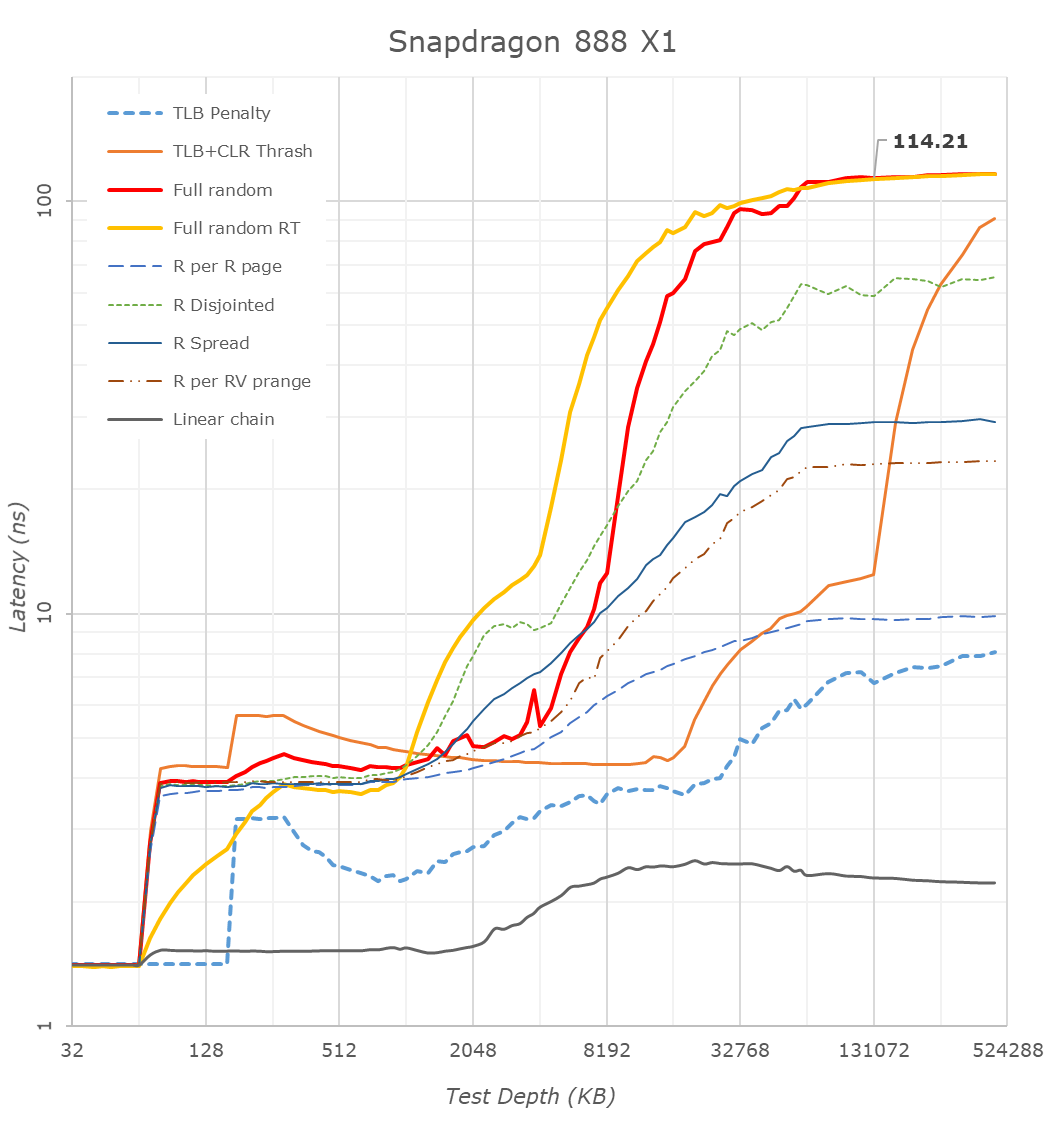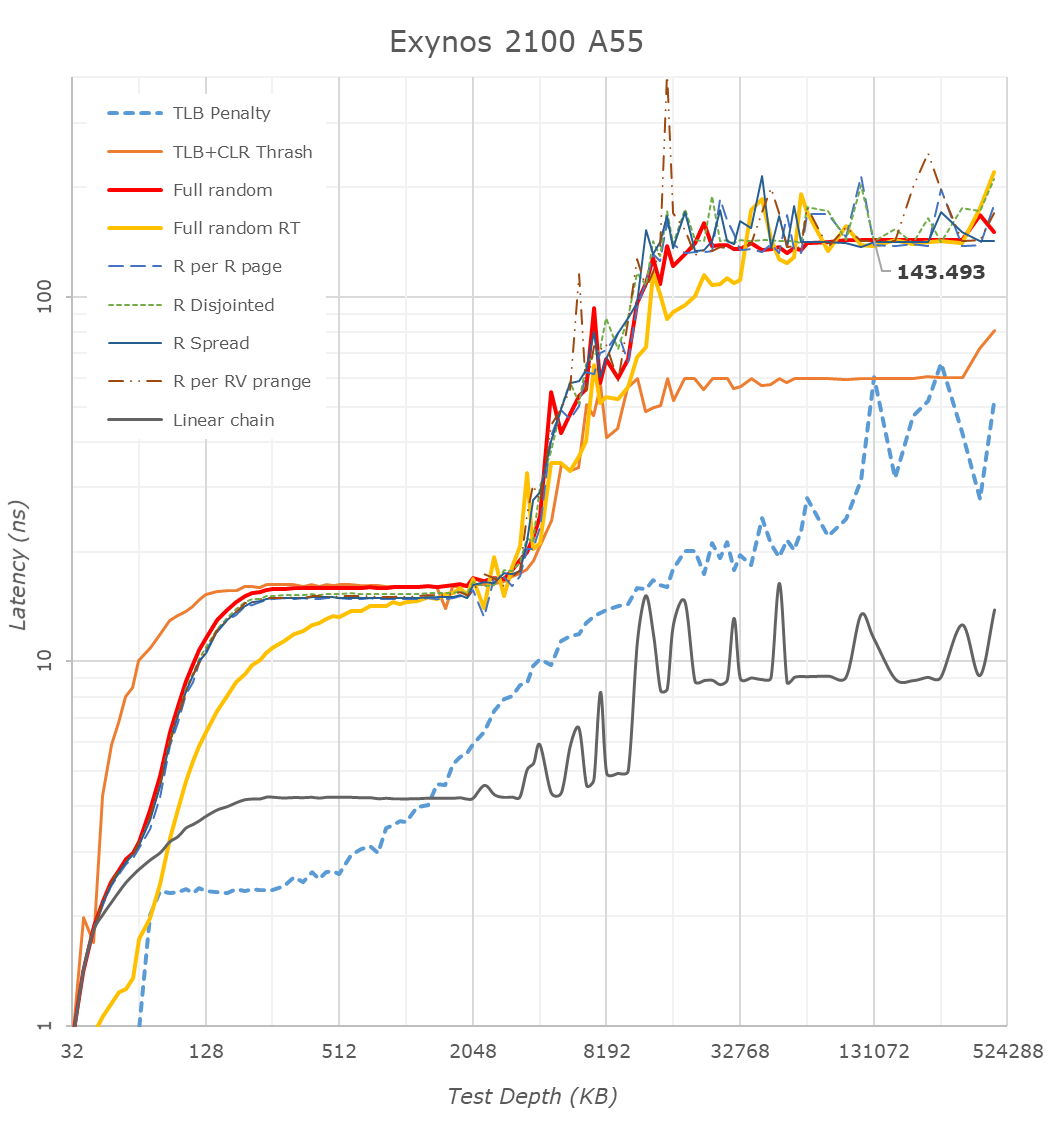The Snapdragon 888 vs The Exynos 2100: Cortex-X1 & 5nm - Who Does It Better?
by Andrei Frumusanu on February 8, 2021 3:00 AM EST- Posted in
- Mobile
- Samsung
- Qualcomm
- Smartphones
- SoCs
- Snapdragon 888
- Exynos 2100
Memory Subsystem & Latency: Quite Different
The memory subsystem comparisons for the Snapdragon 888 and Exynos 2100 are very interesting for a few couple of reasons. First of all – these new SoCs are the first to use new higher-frequency LPDDR5-6400 memory, which is 16% faster than that of last year’s LPDRR5-5500 DRAM used in flagship devices.
On the Snapdragon 888 side of things, Qualcomm this generation has said that they have made significant progress in improving memory latency – a point of contention that’s generally been a weak point of the previous few generations, although they always did keep improving things gen-on-gen.
On the Exynos 2100 side, Samsung’s abandonment of their custom cores also means that the SoC is now very different to the Exynos 990. The M5 used to have a fast-path connection between the cores and the memory controllers – exactly how Samsung reimplemented this in the Exynos 2100 will be interesting.
Starting things off with the new Snapdragon 888, we are seeing some very significant changes compared to the Snapdragon 865 last year. Full random memory latency went down from 138ns to 114ns, which is a massive generation gain given that Arm always quotes that 4ns of latency equals 1% of performance.
Samsung’s Exynos 2100 on the other hand doesn’t look as good: At around 136ns at 128MB test depth, this is quite worse than the Snapdragon 888, and actually a regression compared to the Exynos 990 at 131ns.
Looking closer at the cache hierarchies, we’re seeing 64KB of L1 caches for both X1 designs – as expected.
What’s really weird though is the memory patterns of the X1 and A78 cores as they transition from the L2 caches to the L3 caches. Usually, you’d expect a larger latency hump into the 10’s of nanoseconds, however on both the Cortex-X1 and Cortex-A78 on both the Snapdragon and Exynos we’re seeing L3 latencies between 4-6ns which is far faster than any previous generation L3 and DSU design we’ve seen from Arm.
After experimenting a bit with my patterns, the answer to this weird behaviour is quite amazing: Arm is prefetching all these patterns, including the “full random” memory access pattern. My tests here consist of pointer-chasing loops across a given depth of memory, with the pointer-loop being closed and always repeated. Arm seems to have a new temporal prefetcher that recognizes arbitrary memory patterns and will latch onto them and prefetch them in further iterations.
I re-added an alternative full random access pattern test (“Full random RT”) into the graph as alternative data-points. This variant instead of being pointer-chase based, will compute a random target address at runtime before accessing it, meaning it’ll be always a different access pattern on repeated loops of a given memory depth. The curves here aren’t as nice and they aren’t as tight as the pointer-chase variant because it currently doesn’t guarantee that it’ll visit every cache line at a given depth and it also doesn’t guarantee not revisiting a cache line within a test depth loop, which is why some of the latencies are lower than that of the “Full random” pattern – just ignore these parts.
This alternative patterns also more clearly reveals the 512KB versus 1MB L2 cache differences between the Exynos’ X1 core and the Snapdragon X1 core. Both chips have 4MB of L3, which is pretty straightforward to identify.
What’s odd about the Exynos is the linear access latencies. Unlike the Snapdragon whose latency grows at 4MB and remains relatively the same, the Exynos sees a second latency hump around the 10MB depth mark. It’s hard to see here in the other patterns, but it’s also actually present there.
This post-4MB L3 cache hierarchy is actually easier to identify from the perspective of the Cortex-A55 cores. We see a very different pattern between the Exynos 2100 and the Snapdragon 888 here, and again confirms that there’s lowered latencies up until around 10MB depth.
During the announcement of the Exynos 2100, Samsung had mentioned they had improved and included “better cache memory”, which in context of these results seems to be pointing out that they’ve now increased their system level cache from 2MB to 6MB. I’m not 100% sure if it’s 6 or 8MB, but 6 seems to be a safe bet for now.
In these A55 graphs, we also see that Samsung continues to use 64KB L2 caches, while Qualcomm makes use of 128KB implementations. Furthermore, it looks like the Exynos 2100 makes available to the A55 cores the full speed of the memory controllers, while the Snapdragon 888 puts a hard limit on them, and hence the very bad memory latency, similarly to how Apple does the same in their SoCs when just the small cores are active.
Qualcomm seems to have completely removed access of the CPU cluster to the SoC’s system cache, as even the Cortex-A55 cores don’t look to have access to it. This might explain why the CPU memory latency this generation has been greatly improved – as after all, memory traffic had to do one whole hop less this generation. This also in theory would put less pressure on the SLC, and allow the GPU and other blocks to more effectively use its 3MB size.












123 Comments
View All Comments
Karim Braija - Saturday, February 20, 2021 - link
Parce que je pense que le téléphone galaxy est mieux en terme de qualité et de normalité, et il est sans défauts majeurs et je pense qu'il peut durer bien plus que 10 ans.Cicerone - Sunday, February 28, 2021 - link
OneUI, Samsung Knox, Samsung Pass, Secure Folder, Smart Things, updates ... yes, updates, display, service so. I can be frustrated when in Europe I can have only Exynos soc but I am not. My usage pattern will be far away from the max power of the phone.Spunjji - Monday, February 8, 2021 - link
I rarely trust any kind of blanket statement about "fans" from someone whose username is literally announcing themselves as a single-issue hater.lmcd - Monday, February 8, 2021 - link
Not a Samsung fan. I was hopeful that a new CPU architecture could outperform tiny stock ARM cores and instead ARM delivered a core that wasn't tiny, but happy to pillage bad results when I saw them.This isn't the same deal at all. This imo is equivalent to Qualcomm's 810, which disastrously rushed an A57 implementation and burned Samsung so badly that they doubled down on their current track.
Spunjji - Monday, February 8, 2021 - link
The fact that they switched from their own IP to ARM's without falling behind Qualcomm in the generational cycle would seem to support your hypothesis.That said, whether they'll improve "substantially" does remain to be seen - after all, they'll be integrating AMD GPU tech into a smartphone SoC for the first time since they sold Imageon to Qualcomm.
lmcd - Monday, February 8, 2021 - link
I don't expect the GPU to necessarily match up in efficiency year one, but this CPU result, if it's not from a rushed implementation, is absolutely unacceptable. Qualcomm surely isn't changing X1/A78 that much.melgross - Monday, February 8, 2021 - link
Yeah yeah. Every year someone says that.geoxile - Monday, February 8, 2021 - link
Mali is just crap. The Kirin 9000 is using a lower clocked, 70% wider Mali G78 configuration (MP24 vs MP14) built on TSMC N5, which is head over heels superior to Samsung 5LPE, and efficiency @ peak performance is still only on par with the Exynos 2100 configuration. In power savings mode, where it has an efficiency advantage, it's only 28% better with 70% more cores, so it's obvious avg frequency is throttled way down. Hopefully nvidia takes Mali out to the farm soon.FirePirate3 - Tuesday, February 9, 2021 - link
And why i should care if snapdragon cpu and gpu is marginally better . You won't feel the cpu difference in opening chrome or facebook and such powerful gpus in phones are utterly useless. Are you launching missiles or playing Star Citizen with your smartphones guys? You can play almost all current games with a Mali 400MP gpu. The only thing that matters in this comparation is the battery life where we should give the props to qualcomm, but this is the only thing that actually matters.iphonebestgamephone - Tuesday, February 9, 2021 - link
Nah, these days there are games that support 144fps and stuff, you need something like adreno 618 and up. For some stuff like genshin, to do max graphics wiyh constant 50+ fps you basically need a sd865 minimum.